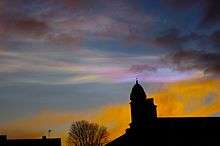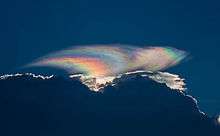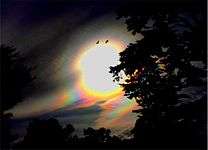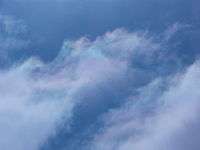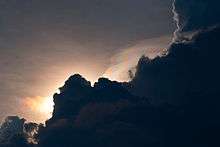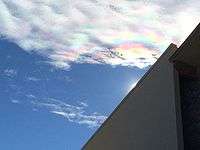Cloud iridescence
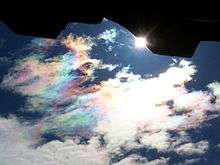
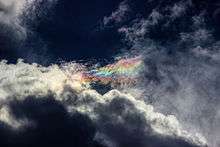
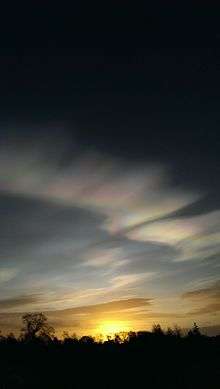
Cloud iridescence is the occurrence of colors in a cloud similar to those seen in oil films on puddles, and is similar to irisation. It is a fairly uncommon phenomenon, most often observed in altocumulus,[1] cirrocumulus, lenticular clouds and cirrus clouds.[2][3][4] The colors are usually pastel, but can be very vivid. Iridescence is generally produced near where the sun appears in the sky, with the sun's glare masking it, so it is more easily seen by hiding the sun behind a tree or building. Other aids are dark glasses, or observing the sky reflected in a convex mirror or in a pool of water. Or one can simply block the sun (but not the cloud) with the palm of one's hand.
Iridescent clouds are a diffraction phenomenon caused by small water droplets or small ice crystals individually scattering light. Larger ice crystals produce halos.
If parts of clouds have small droplets or crystals of similar size, their cumulative effect is seen as colors. The cloud must be optically thin, so that most rays encounter only a single droplet. Iridescence is therefore mostly seen at cloud edges or in semi-transparent clouds, and newly forming clouds produce the brightest and most colorful iridescence. When a thin cloud has droplets of similar size over a large extent, the iridescence takes on the structured form of a corona, a central bright disk around the sun or moon surrounded by one or more colored rings. In one instance a lunar corona was observed, with the iridescent cirrus cloud 11–13.6 km (36,000–45,000 ft) above the mean sea level at a temperature of −70 °C (−94 °F). The pure corona was 9.5 km (31,000 ft) above the mean sea level, at a temperature of −60 °C (−76 °F).[5]
Gallery
See also
References
- ↑ Gedzelman, Stanley David (1 June 1988). "In Praise of Altocumulus". Weatherwise. 41 (3): 143–149. doi:10.1080/00431672.1988.9930533.
- ↑ Nemiroff, R.; Bonnell, J., eds. (25 November 2007). "An Iridescent Cloud Over Colorado". Astronomy Picture of the Day. NASA.
- ↑ Iridescent Clouds - Atmospheric Optics site
- ↑ Sassen, Kenneth (1 January 2003). "Cirrus cloud iridescence: a rare case study". Applied Optics. 42 (3): 486. Bibcode:2003ApOpt..42..486S. doi:10.1364/AO.42.000486.
- ↑ Shaw, Joseph A.; Pust, Nathan J. (12 August 2011). "Icy wave-cloud lunar corona and cirrus iridescence". Applied Optics. 50 (28): F6. Bibcode:2011ApOpt..50F...6S. doi:10.1364/AO.50.0000F6.
External links
| Wikimedia Commons has media related to Iridescent clouds. |
| Look up iridescent cloud in Wiktionary, the free dictionary. |
- Iridescent cloud gallery - Atmospheric Optics site
- On the Cause of Iridescence in Clouds - Scientific American Supplement
